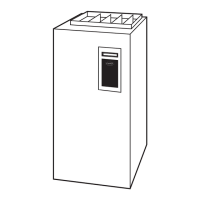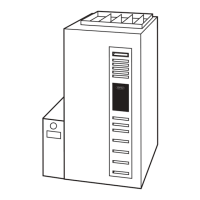INSTALLATION
Step 1—Leveling Legs (If Desired)
When furnace is used in upflow position with side inlet(s), leveling
legs may be desired. (See Fig. 18.) Install field-supplied,
corrosion-resistant 5/16-in. machine bolts and nuts.
NOTE: The maximum length of bolt should not exceed 1-1/2 in.
1. Position furnace on its back. Locate and drill a 5/16-in.
diameter hole in each bottom corner of furnace. (See Fig. 18.)
Holes in bottom closure panel may be used as guide locations.
2. For each hole, install nut on bolt and then install bolt and nut
in hole. (Install flat washer if desired.)
3. Install another nut on other side of furnace base. (Install flat
washer if desired.)
4. Adjust outside nut to provide desired height, and tighten inside
nut to secure arrangement.
NOTE: Bottom closure must be used when leveling legs are used.
See Bottom Closure Panel section.
Step 2—Installation in Upflow or Downflow
Applications
NOTE: This furnace is approved for use on combustible flooring
when manufacturer’s accessory floor base, Part No.
KGASB0201ALL, is used. Manufacturers accessory floor base in
not required when this furnace is installed on manufacturer’s Coil
Assembly Part No. CD5 or CK5, or Coil Box Part No. KCAKC is
used.
1. Determine application being installed from Table 1.
2. Construct hole in floor per dimensions specified in Table 1
and Fig. 19.
3. Construct plenum to dimensions specified in Table 1 and Fig.
19.
4. If downflow subbase (KGASB) is used, install as shown in
Fig. 20.
If coil assembly CD5 or CK5 or Coil Box KCAKC is used,
install as shown in Fig. 21.
NOTE: Remove furnace perforated discharge duct flanges when
they interfere with mating flanges on coil on downflow subbase.
To remove furnace perforated discharge duct flange, use hand
seamers, wide duct pliers or duct flange tool to bend flange back
and forth until it breaks off. Be careful of sharp edges. (See Fig.
22.)
Do not bend duct flanges inward as shown in Fig. 22. This
will affect airflow across heat exchangers and may cause limit
cycling or premature heat exchanger failure. Remove duct
flange completely or bend it inward a minimum of 210° as
shown in Fig. 22.
Step 3—Installation in Horizontal Applications
These furnaces can be installed in either horizontal left or right
discharge position. In a crawlspace, furnace can either be hung
from floor joist or installed on suitable blocks or pad. Furnace can
be suspended from each corner by hanger bolts and angle iron
supports. (See Fig. 23.) Cut hanger bolts (4 each 3/8-in. all-thread
rod) to desired length. Use 1 X 3/8-in. flat washers, 3/8-in.
lockwashers, and 3/8-in. nuts on hanger rods as shown in Fig. 23.
Dimples are provided for hole locations. (See Fig. 2.)
The entire length of furnace MUST be supported when
furnace is used in a horizontal position to ensure proper
draining. When suspended, bottom brace supports sides and
center blower shelf. When unit is supported from the ground,
blocks or pad should support sides and center blower shelf
area. Failure to follow this caution will result in intermittent
unit operation or performance satisfaction.
Step 4—Air Ducts
GENERAL REQUIREMENTS
The duct system should be designed and sized according to
accepted national standards such as those published by: Air
Conditioning Contractors Association (ACCA), Sheet Metal and
Air Conditioning Contractors National Association (SMACNA) or
American Society of Heating, Refrigerating and Air Conditioning
Engineers (ASHRAE) or consult The Air Systems Design Guide-
lines reference tables available from your local distributor. The
duct system should be sized to handle the required system design
CFM at the design static pressure.
When a furnace is installed so that the supply ducts carry air
circulated by the furnace to areas outside the space containing the
furnace, the return air must also be handled by a duct(s) sealed to
the furnace casing and terminating outside the space containing the
furnace.
Secure ductwork with proper fasteners for type of ductwork used.
Seal supply- and return-duct connections to furnace with code
approved tape or duct sealer.
Flexible connections should be used between ductwork and
furnace to prevent transmission of vibration. Ductwork passing
through unconditioned space should be insulated to enhance
system performance. When air conditioning is used, a vapor
barrier is recommended.
Maintain a 1-in. clearance from combustible materials to supply air
ductwork for a distance of 36 in. horizontally from the furnace. See
NFPA 90B or local code for further requirements.
For a furnace not equipped with a cooling coil, the outlet duct shall
be provided with a removable access panel. This opening shall be
accessible when the furnace is installed and shall be of such a size
that the heat exchanger can be viewed for possible openings using
light assistance or a probe can be inserted for sampling the air
stream. The cover attachment shall prevent leaks.
Fig. 18—Leveling Legs
A89014
1
3
⁄4″
1
3
⁄4″
1
3
⁄4″
1
3
⁄4″
5
⁄16″
5
⁄16″
5
⁄16″
5
⁄16″
15
→

